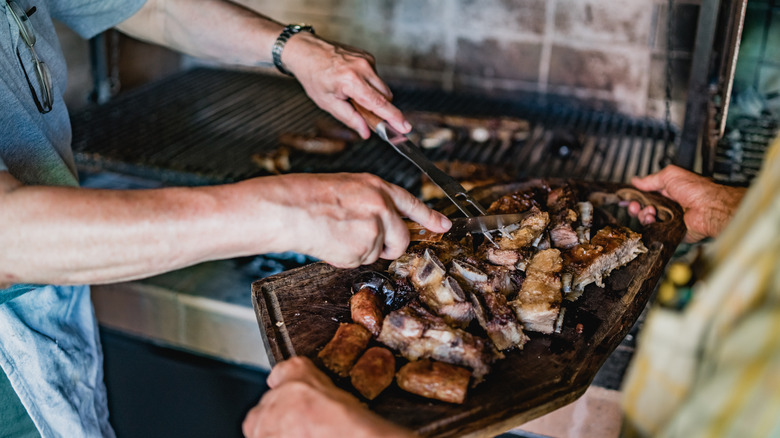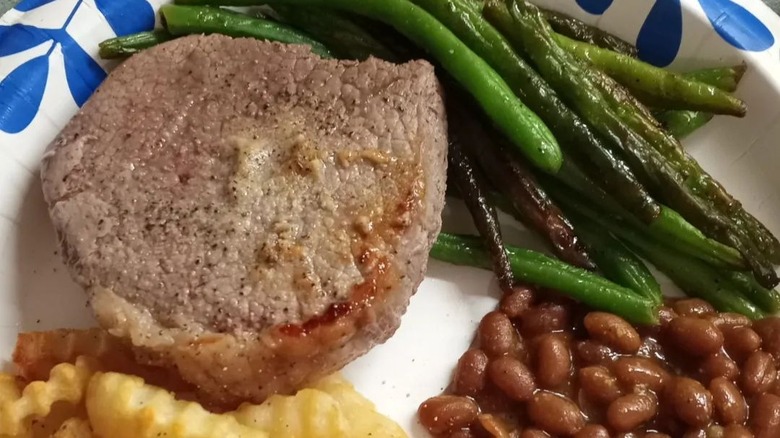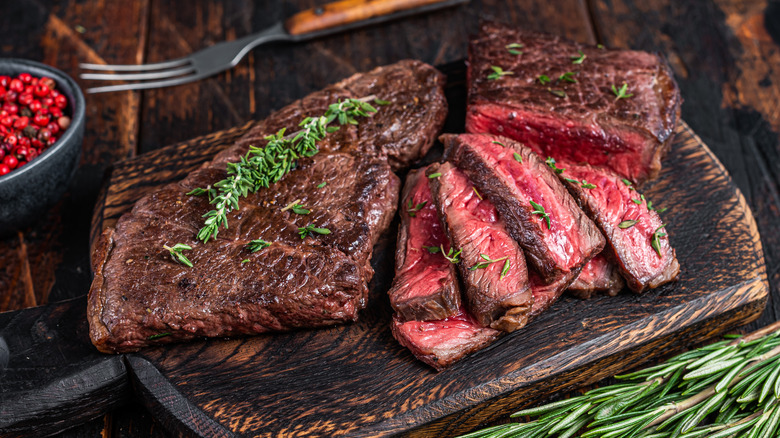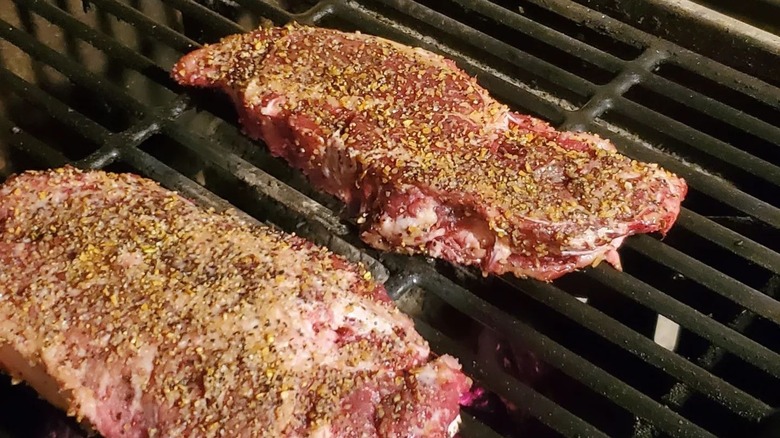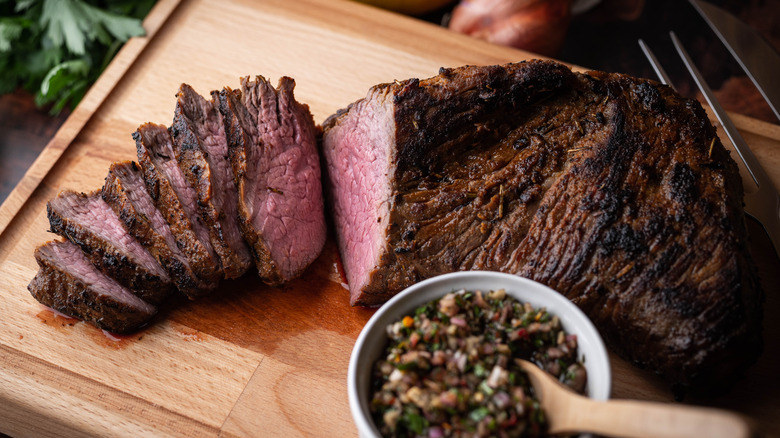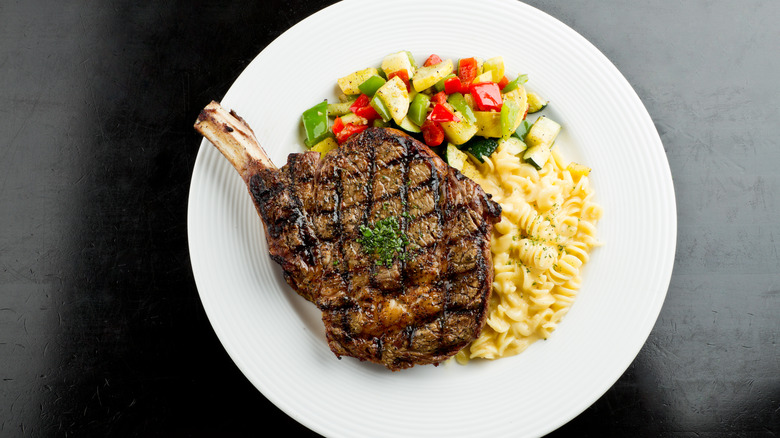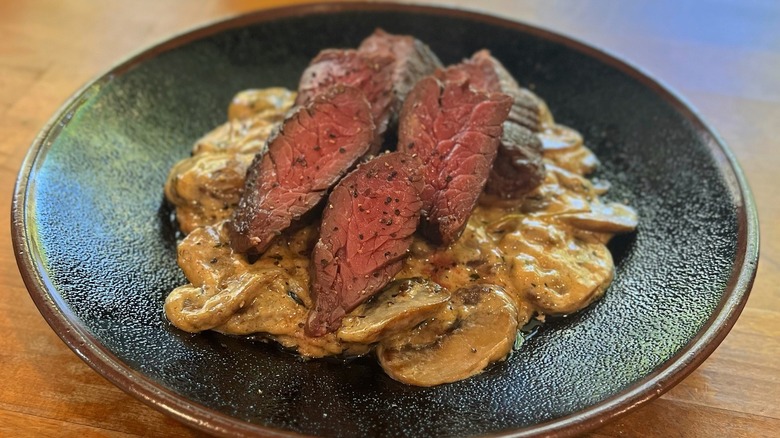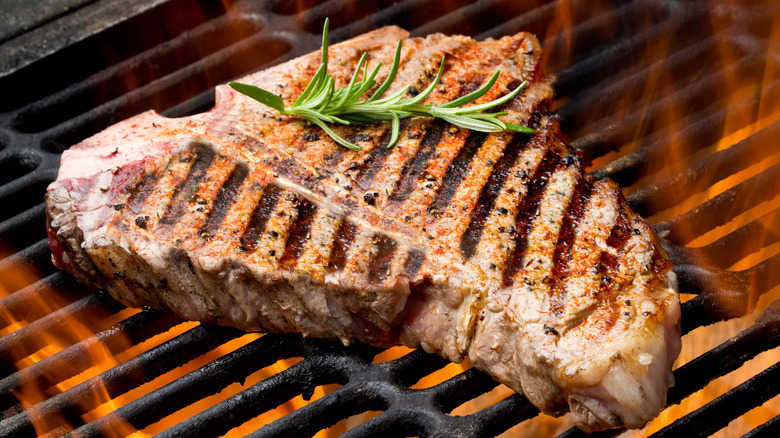7 Cuts Of Steak Chefs Say Amateurs Mess Up The Most
The delicious, tender, and mouthwatering appeal of steak can be hard to resist. From juicy filet mignons to tenderloins, it can be tempting for home cooks to recreate dishes from their favorite steakhouse chains in the comfort of their own kitchen. And while certain steaks can be equally decadent when cooked by less experienced chefs, that rule does not apply to all cuts.
Some steaks are more complicated to cook and require a bit more than simply throwing meat on the grill or popping it into a cast iron skillet. These tougher cuts require additional experience and preparation, making them an option most home cooks should stay away from. While kitchen tools like meat thermometers may make the cooking process a bit easier and more precise, these cuts are still a challenge for most home chefs.
We asked experts to identify the steaks home cooks should avoid, so you can shop more strategically next time you hit the grocery store looking to satisfy your steak fix. Read on to discover the cuts chefs say amateurs mess up the most, so you don't waste time, money, or effort on a meal that doesn't turn out as you'd hoped.
1. Eye-round steak
All round steaks are found on the back of the cow in a heavily muscled area near the rear legs. Because these muscles are used for frequent movement, this part of the cow has a low fat content, which means the beef isn't as tender. As a result, these tougher cuts can be more difficult to cook than steaks with well-marbled muscle and fat. Additionally, eye-round steak is often more affordable than other cuts, which makes it a desirable option for many home chefs. But tread carefully; when cooked incorrectly, eye-round steak is chewy and tough, resulting in an unpleasant dining experience.
Certain cooking methods like braising, sous vide, or slow cookers, can make eye-round steak more tender and enjoyable to eat but they require a lot of time, patience, and practice to perfect. Marinating the steak beforehand can also help tenderize the beef, according to Ashley Lonsdale, ButcherBox chef-in-residence. "The salt in the marinade will help tenderize the meat and you can introduce more aromatics." Like the slow-cooking methods, marinating your eye-round before cooking requires more time and forethought. If you want a quick, easy dinner to put on the table, eye-round is not it.
2. Skirt steak
Skirt steak is cut from an area on the cow's belly known as the plate. This section of the animal is much fattier than the heavily-muscled round, which might make skirt steak seem like a great candidate for home cooks. However, the cut is peppered with connective tissue that can be tough and chewy once cooked. Because it is cut from the belly in a single piece, skirt steak can also be an awkward shape — it is usually thin and narrow and can be up to two feet long.
The thinness of the cut is also one of the factors that makes it difficult to cook. Skirt steak is most flavorful and tender when served medium or medium-rare. Even when cooked just a minute too long, the result will be tough and dry. Achieving this nuance at home — whether on a grill, under a broiler, or in a pan — can be a very difficult feat for inexperienced home chefs. A suitable alternative to skirt steak is flank steak. "Flank steak is a great cut. It's easy to identify the grain to slice against when it's time to serve, and it can feed multiple people!" says Lonsdale.
3. Chuck-eye steak
All chuck cuts come from the cow's neck and shoulders. Like the round, this area is filled with muscle and connective tissue, which limits the fat content. While chuck is often turned into ground beef, it can also be purchased in larger steaks for a steal — but proceed with caution.
Also known as the shoulder steak or London broil, chuck-eye steak can be seared in a pan or on a grill and then cooked over low heat until it's about medium-rare (not to be confused with chuck roast, which should be cooked for a long time over slow heat). If cooked too long, you'll be left with a chewy, tough bite.
Barry Sorkin, owner of Smoque Steak, recommends home chefs avoid heavily-muscled cuts like chuck-eye steak because of their difficulty to perfect. "For the home cook, I recommend cooking steaks that are naturally tender, boneless, well-marbled, and relatively uniform. These characteristics offer the less experienced cook a good deal of forgiveness and even cooking and are suited for a number of different cooking methods."
4. Tri-tip steak
Tri-tip steak — often called California's cut — is an often-overlooked steak cut from the bottom of the sirloin found on the cow's belly. Earning its name from its distinctive shape, this steak has very little fat and is always boneless. Tri-tip is sometimes sold with a fat cap on one side, requiring extra trimming once purchased. This prep step alone is a hurdle for home chefs, as the more desirable cuts are typically ready-to-go right from the butcher.
Because of its asymmetric size, it is also difficult to cook consistently. Often, when the steak comes out of the oven or off the grill, the smaller end is cooked more than the wider, thicker end, which tends to still be on the rarer side. While this may be an advantage if you're cooking for a crowd with varied preferences, this uneven result is often a negative when preparing tri-tip for a small group or individual.
Even if cooked correctly, tri-tip steak can still be chewy and tough if it's not cut properly. This steak has two different grains, with some running vertically and the rest running horizontally. Cutting the cooked steak along this intersection, and then cutting it into smaller pieces from there, is vital to ensuring you have tender steak. It can, however, be a difficult task for those who aren't familiar with the cut or aren't comfortable butchering.
5. Bone-in ribeye
Bone-in ribeye is cut from the cow's lower ribs, with part of the rib bone left attached. Many people prefer to purchase bone-in ribeye versus the boneless steak because they feel the bone infuses additional flavor. While the jury is out on whether or not the bone actually adds flavor to the steak, one thing is clear: Leaving the bone in makes the steak much easier for home chefs to mess up.
Sorkin agrees that bone-in cuts aren't the best option for home chefs. "Bones can add significant cost to your raw product and make it more difficult to cook the steak evenly," he says. "Bones can insulate the steak from the heat source, making the meat around the bone cook at a slower rate than the rest of the steak." With bone-in cuts like ribeye, home chefs may run into issues where the meat closest to the bone is underdone or even raw, while the meat around the steak's edges is cooked properly. Because of the touchy nature of this cut, it's best left to the experts.
6. Hanger steak
Like skirt steak, hanger steak is a thin cut that comes from the plate of the cow. There's only one hanger steak per cow, however, so it can be more difficult than other cuts to find at chain supermarkets. This low supply also makes it a less sustainable cut than other popular steaks like flank steak or even ground beef.
Though naturally tender with a good fat content, it has a membrane that runs down the center of the cut. When this membrane is left in the steak, it causes the steak to be chewy and tough. Once the membrane is removed, hanger steak can be cooked to range of doneness, from rare to medium, depending on your personal preference.
However, getting the perfect internal temperature for your preferred cook can be a challenge to time on such a thin cut. Even just a minute or two longer on the grill or in the pan can cause the steak to be too tough to enjoy. If you take it off when it's too rare, the meat will have an overly soft texture. Striking that perfect middle ground is extremely difficult for those who are less experienced cooking steak.
7. T-bone steak
T-bone steaks get their name from the distinctive, T-shaped bone that runs through the center of the cut. Sourced from the cow's short loin, the T-bone has a different type of steak on each side: strip steak and tenderloin. T-bones are very similar to porterhouse steaks; both are from the short loin and have the same T-shaped bone, but a porterhouse filet must be at least 1.25 inches thick, according to USDA requirements.
Whether cooking a T-bone or a porterhouse, as with other bone-in cuts, the meat closest to the bone also cooks at a different rate. The bone insulates the surrounding meat, making it heat up more slowly, which can lead to uneven levels of doneness along both sides of the steak. Because there are two different cuts, it's important to strategically choose a cooking method that will cook both sides at the same rate, such as a grill with two heat zones.
Instead of a cut like a T-bone, Sorkin recommends bone-free alternatives. "I like a ribeye. Its natural tenderness, rich flavor, and good marbling deliver great flavor and tenderness and will stay juicy even if slightly overcooked."
